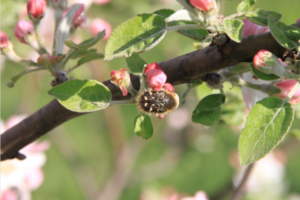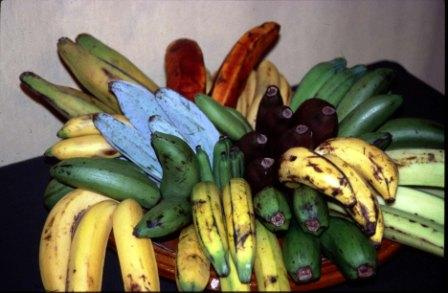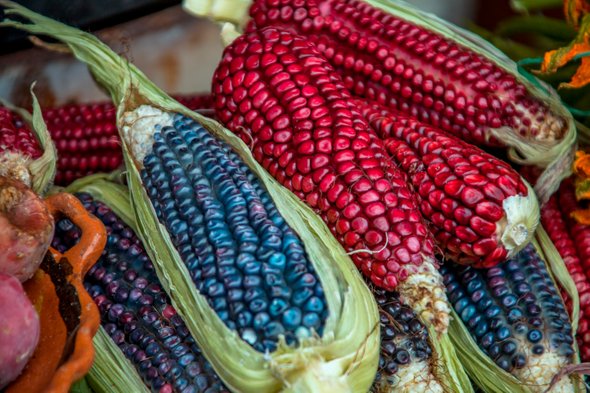Native Plant Conservation Campaign News: United Nations - The biodiversity underpinning our food security is disappearing
February 27, 2019
According to the UN Food and Agriculture Organization, some 821 million people suffer from chronic hunger, nearly a quarter of children under the age of five are stunted, and malnutrition affects a third of the global population.

NPCC News has discussed the ways in which healthy, diverse native plant communities improve agricultural productivity and stabilize the food supply (see the
NPCC News Archive, search “food”).
Native plants protect food security in several ways, including:
- They provide habitat for wildlife (birds, bats, bees) that pollinate crops and perform pest control
- They increase and protect soil fertility and productivity
- They are reservoirs of species and genetic diversity essential to crop resilience in the face of pests, disease and climate change
Two international initiatives to conserve the native plants and other biodiversity that underpin our food security have been announced:
- United Nations Food and Agriculture Organization released The State of the World’s Biodiversity for Food and Agriculture in January.
This is the first global assessment of biodiversity for food and agriculture worldwide. The report reviews the roles of plants, microorganisms and animals in stabilizing the world’s food supply.
The report defines “
biodiversity for food and agriculture” as the diversity of plants, animals and micro-organisms that are fundamental to agriculture and other food production. The report provides a detailed description of the roles of biodiversity in the production, resilience and stability of our food supply. It also discusses efforts to conserve this biodiversity through laws, policies and institutions and calls for protection of biodiversity in order to

protect humanity.
Unfortunately, but not surprisingly, the report found that the biodiversity that is crucial to food production is imperiled. As reported in
the Guardian:
‘Many species that are indirectly involved in food production, such as birds that eat crop pests and mangrove trees that help to purify water, are less abundant than in the past, noted the study, which collated global data, academic papers and reports by the governments of 91 countries.
It found 63% of plants, 11% of birds, and 5% of fish and fungi were in decline. Pollinators, which provide essential services to three-quarters of the world’s crops, are under threat. As well as the well-documented decline of bees and other insects, the report noted that 17% of vertebrate pollinators, such as bats and birds, were threatened with extinction.’
While changes to the climate may be reversible in time, there is no going back once species become extinct. The FAO notes “This places the future of our food and the environment under severe threat.”’
- Meanwhile, here in North America, a Roadmap on Plant Conservation, Use, and Public Engagement is under development.
The goal of the Roadmap is to conserve the wild relatives of the plants we depend upon for food. In other words, it seeks to conserve the native plants whose genetic diversity can be used to help food crops resist climate change and other threats.
Just five crops – rice, wheat, maize, millet and sorghum – provide about half of human food-energy needs. Most of these crops are grown as genetically homogeneous monocultures, making them very vulnerable to pests and disease, as well as less able to adapt to climate change.
The FAO report noted that overdependence on a narrow range on genetically identical food species was a major factor in the famine caused by potato blight in Ireland in the 1840s, corn and other cereal crop failures in the US in the 20th century, and losses of taro production in Samoa in the 1990s.
The Roadmap seeks to create a succinct strategic framework for working together to conserve crop wild relatives, wild utilized plants, their genetic resources and habitats.
The draft Roadmap is not available online so it is pasted below.
Photos, all public domain:
Beetle pollinating apple blossom
Banana diversity
Corn divesity
Roadmap on Plant Conservation and call to action.
From the authors:
The DRAFT Des Moines Roadmap on Plant Conservation, Use, and Public Engagement will be shared and workshopped at the Celebrating Crop Diversity Symposium in Des Moines, Iowa, April 2-4. The Roadmap aims to create a high level and succinct strategic framework for working together for crop wild relatives and wild utilized plants. Crop wild relatives and their genetic resources are essential to our common future. Achieving comprehensive conservation, use and public awareness of crop wild relatives in North America requires shared goals and collaborative effort across institutions, disciplines, and countries. A clear road map will help us reach our destination of secure crop wild relatives.
This is where we need your input! As experts and engaged colleagues we are seeking broad input from people active in the field.
Call to action 1: Please REVIEW the below DRAFT Des Moines Roadmap on Plant Conservation, Use, and Public Engagement.
Call to action 2: Have your voice heard! Please provide your input by completing this survey from the University of British Columbia
We estimate that it will take only 20 minutes to review the Roadmap and complete the survey. The survey will be open until Feb 28th, 2019. The input gathered will be reviewed by the working group and updates will be presented in April at the Celebrating Crop Diversity Symposium.
We are grateful for your input!
The Des Moines Road Map on Plant Conservation, Use, and Public Engagement:
Uniting Conservationists, Scientists, and Educators Around North America’s Crop Wild Relatives and Wild Utilized Plants
DRAFT VERSION FOR INPUT Feb 12, 2019
THE NEED: Increasing the productivity, sustainability, and nutritional quality of our food systems is essential to nourishing humanity for the long term. Mitigating the profound losses of biodiversity sweeping the world is vital to a future that we want to live in. These needs converge with crop wild relatives - the wild cousins of agricultural plants - which have tremendous value to crop productivity, sustainability, and nutrition through plant breeding. These needs also apply to wild utilized plant species, which continue to provide food and a variety of other ecosystem and cultural services to humanity. Many of these useful wild plants are threatened in their natural habitats and are not well represented in conservation repositories. Urgent conservation attention is required if they are to contribute to our shared future.
THE OPPORTUNITY: North America has a rich flora of wild relatives of food and agricultural crops - wild apples, beans, blueberries, chili peppers, corn, cotton, grapes, hops, onions, pumpkins, sunflowers, and many more. These natural resources can provide important and useful improvements to our domesticated species. The region is also home to a diversity of significant wild utilized plants, such as sugar maple and wild rice. Unfortunately, these useful wild plants are poorly represented in regional genebanks, botanical gardens, and other ex situ repositories, and many are threatened in their natural habitats. Identifying and addressing conservation gaps, facilitating their use in plant breeding, and raising the collective awareness of the value of these plants as well as the threats to their survival all require partnerships across plant conservation, land management, agricultural science, and botanical education and outreach organizations.
Our collective as well as individual actions in recent years have brought us to the point where we are institutionally and scientifically prepared to embark on an ambitious effort to comprehensively conserve, make available, and raise awareness about the importance of crop wild relatives and wild utilized plants of North America. Key conservation, land management, agricultural research, and botanical garden institutions in North America are eager to take up the challenge of maximizing the contribution of native wild species to food and nutrition security and to sustainable agriculture, thus helping to fulfill important agriculture, biodiversity conservation, and sustainable development commitments. Public genebanks make crop diversity accessible to scientists and plant breeders around the world. Land management agencies are responsible for large portions of North America, and almost 1000 botanical and public gardens are located across the region, educating local visitors and performing important conservation, research, and public awareness activities. Collaborations across these institutions are growing, including for important crop wild relatives such as wild chili peppers, cranberries, and sunflowers. A variety of existing institutional frameworks and agreements facilitate initiatives between these organizations and across borders.
THE DES MOINES ROAD MAP: To accomplish our goals, we must act soon, and we must work together. We endorse an ambitious regional initiative built on partnerships between plant conservation, land management, agricultural science, and botanical education and outreach organizations to take collective action to 1) understand and document North America’s crop wild relatives and wild utilized plants, 2) collect and conserve their diversity, 3) make their diversity accessible for plant breeding, research, and education, 4) protect threatened species in their natural habitats, and 5) raise public awareness of their value and the threats to their persistence. Through our collective network we endorse these five priorities for strategic action, which will be necessary to the successful conservation, use, and celebration of our crop wild relatives and wild utilized plants.
1 - Combine forces to understand and document North America’s crop wild relatives and wild utilized plants, assess threats to their natural habitats, and determine gaps in their conservation. A collaborative assessment is needed to document and define the highest priority species, understand patterns of diversity, and identify gaps in conservation. Of equal importance is to identify poorly recognized North American plant species with potential future agricultural significance. Results must be shared widely with relevant professionals in the conservation, land management, and crop science communities, and with the general public.
2 - Collaborate on collecting and conserving North America’s crop wild relatives and wild utilized plants in ex situ collections (as plants, tissues or seeds). Prioritized crop wild relatives and wild utilized plants across North America need systematic collecting, coordinated by botanic, taxonomic, and conservation experts and capitalizing on local botanical expertise, while providing training and educational opportunities for participants. The plants then need to be processed and stored in ex situ conservation repositories in conditions that will enable their survival for the long-term.
3 - Collaborate on making North America’s crop wild relatives and wild utilized plants accessible to plant breeders, researchers, and educators. These plants need to be carefully managed to ensure adequate, high quality, true to type propagules are available for distribution, and they need to be easily accessible via online databases. Indigenous, traditional, and local knowledge about these plants must be valued and protected in accordance with transparent agreements. These plants should also be accessible to the public through botanic garden displays and through information initiatives on public lands.
4 - Cooperate on protecting North America’s crop wild relatives and wild utilized plants in their natural habitats. Conservation sites for populations of the highest priority crop wild relatives and wild utilized plants need to be designated in existing protected areas, and additional protected areas need to be advocated for, as necessary to adequately protect the genetic diversity of these plants in their natural habitats so they can continue to evolve.
5 - Combine forces to raise public awareness about North America’s crop wild relatives and wild utilized plants. Creating coordinated educational and communications programs to help raise awareness and provide a backdrop for ongoing support of crop wild relative and wild utilized plant conservation, while respecting, preserving and maintaining associated indigenous and local knowledge, is necessary to the long-term viability of conservation and plant breeding efforts. Skilled education and outreach professionals should lead collaborative efforts to raise awareness about the importance of, and threats to, our useful wild plants.


 protect humanity.
protect humanity.